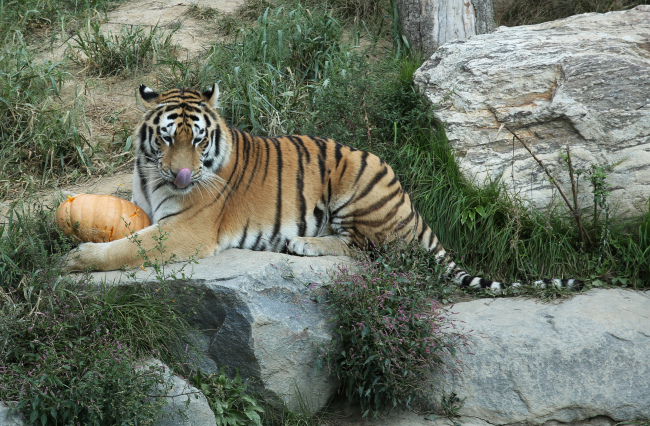[Weekender] Tourism or preservation -- what are zoos for?
By Yeo Jun-sukPublished : Sept. 30, 2016 - 17:16
South Korea’s filmmaker Hwang Yoon shot a movie titled “Farewell” in 2002 featuring a baby tiger who lives at a zoo in Seoul. Being born out of incest encouraged by zookeepers, the little tiger – named “Crane” -- was predisposed to cataracts and had a deformed face.
Ten years later, Hwang reunited with Crane, who was relocated to a zoo in Gangwon Province after losing popularity among Seoul spectators when it became bigger and older. By the time Hwang saw Crane, the tiger had fallen ill because the financially troubled zoo could not afford enough food for him.
Ten years later, Hwang reunited with Crane, who was relocated to a zoo in Gangwon Province after losing popularity among Seoul spectators when it became bigger and older. By the time Hwang saw Crane, the tiger had fallen ill because the financially troubled zoo could not afford enough food for him.

The story of the little tiger Crane sparked a debate here within social and scientific communities: whether the government should keep allowing private or public entities to keep wild animals in the name of conservation.
While some groups argue that taking in animals from the wild is crucial to protect species and educate the public, others say that any preservation strategy that involves violence or captivity should be stopped and demand alternatives to cruel practices.
“No matter how ‘natural’ they make the animals’ caged-in areas, once zoos recreate an area, it is now artificial and unnatural,” American animal rights activist Gary Yourofsky wrote on his website Animals Deserve Absolute Protection Today and Tomorrow.
The activists assert that modern-day zoos must be transformed into sanctuaries for wild animals, allowing animals to live out their lives, while visitors can be given a virtual ride in such areas as an auditorium to see them.
Animals living in zoos are exempt from laws dealing with animal protection in Korea. Zoos can be built by anyone in accordance with the Museum and Art Gallery Support Act and Tourism Promotion Act -- none of which include clauses preventing abuse.
South Korea’s Animal Protection Act, which took effect in 2014, stipulates that the term “abuse” should be defined as a behavior causing injury and death. Other disciplinary behavior on animals, such as punishment during training for animal shows, is not banned, animal activists groups point out.
Some lawmakers here attempted to enact laws aiming to prevent abuses at the zoos. They sought to ban zoos from imposing harsh training on animals for entertainment shows and restrict what they saw as “unqualified” entities from building zoos with poor environment.
Among them was a bill sponsored by Jang Han-na, a former lawmaker of the main opposition The Minjoo Party of Korea. Titled “bill for managing zoos and aquariums,” the legislation cleared the National Assembly in May 2016 during its final plenary session. It was nearly three years after draft bill was submitted.
But the bill was criticized for amendments to some key clauses. According to the final version of the law, any entity can run zoos as long as they get approval from the government. The draft version forced the authority to approve the operation only if they deem that the zoo provides adequate environment for the animals.
“We feel more disappointed than welcoming,” the Korea Animal Welfare Association said in a statement published after the bill was signed into law. “It is regression from the draft version and we might as well pin our hopes on the next Assembly.”
Chang claimed that there was “systematic interference” in the legislative efforts by conglomerates who own private zoos and aquariums.
Denying the allegation, the zoo operators asserted that imposing stricter laws would push out minor zoos and hamper their efforts to preserve species. “Almost all private zoos would have closed their businesses if the law had been passed as intended,’ Noh Jung-rae, a former head of Seoul Zoo, said in a media interview.
Experts suggested that the government should officially designate the role of zoos as promoting biodiversity – and the zoos themselves also should move beyond tourism attractions to become places to preserve endangered species.
“The most important role of the zoo is to preserve species,” said Lee Hang, a professor at Seoul National University who teaches evolutionary biology and zoology. “The government should implement laws that stipulates the purpose of zoos is species preservation, not public entertainment.”
By Yeo Jun-suk (jasonyeo@heraldcorp.com)



![[AtoZ into Korean mind] Humor in Korea: Navigating the line between what's funny and not](http://res.heraldm.com/phpwas/restmb_idxmake.php?idx=644&simg=/content/image/2024/04/22/20240422050642_0.jpg&u=)

![[Exclusive] Korean military set to ban iPhones over 'security' concerns](http://res.heraldm.com/phpwas/restmb_idxmake.php?idx=644&simg=/content/image/2024/04/23/20240423050599_0.jpg&u=20240423183955)

![[Herald Interview] Why Toss invited hackers to penetrate its system](http://res.heraldm.com/phpwas/restmb_idxmake.php?idx=644&simg=/content/image/2024/04/22/20240422050569_0.jpg&u=20240422150649)
![[Graphic News] 77% of young Koreans still financially dependent](http://res.heraldm.com/phpwas/restmb_idxmake.php?idx=644&simg=/content/image/2024/04/22/20240422050762_0.gif&u=)






![[Exclusive] Korean military to ban iPhones over security issues](http://res.heraldm.com/phpwas/restmb_idxmake.php?idx=652&simg=/content/image/2024/04/23/20240423050599_0.jpg&u=20240423183955)



![[Today’s K-pop] Ateez confirms US tour details](http://res.heraldm.com/phpwas/restmb_idxmake.php?idx=642&simg=/content/image/2024/04/23/20240423050700_0.jpg&u=)